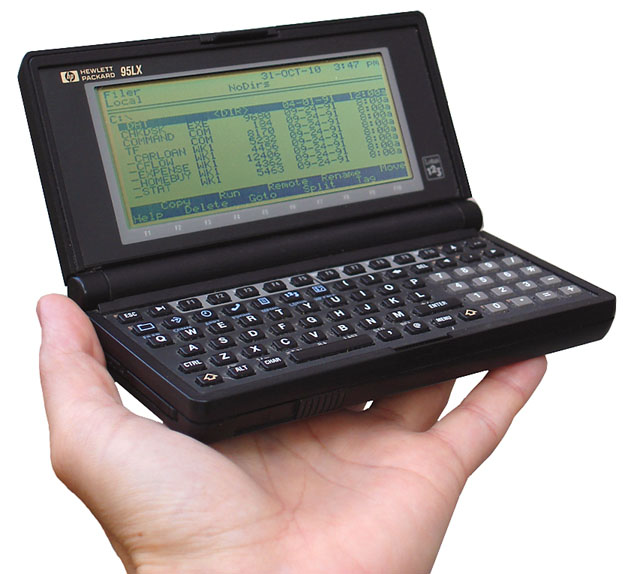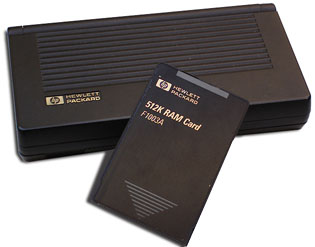
Like most pocket computers, the HP 95LX owner's manual is larger and heavier than the computer itself.
|
| Also known as |
Jaguar |
| Manufacturer |
Hewlett-Packard[1] |
| Type |
Palmtop PC |
| Release date |
April 1991; 24 years ago[2] |
| Introductory price |
$550 |
| Discontinued |
January 1, 2003 |
| Units shipped |
400,000 (estimated production run) |
| Operating system |
Microsoft MS-DOS 3.22 |
| CPU |
NEC V20 @ 5.37 MHz |
| Memory |
512 KB (F1000A) or 1 MB (F1010A)[3] |
| Removable storage |
SRAM card (0.5MB - 32MB) |
| Display |
16 x 40 characters LCD screen (4.8 in x 1.8 in) |
| Graphics |
128 x 240 pixels(quarter-CGAresolution) monochrome STN , 2 scales |
| Sound |
PC Speaker - Piezo |
| Input |
Thumb keyboard w/80 keys & dedicated numeric keypad[4][5][6] |
| Connectivity |
RS-232-compatible serial port, infrared port, PCMCIA 1.0 type II (3.3mm or 5mm) |
| Power |
2x AA-size removable batteries, 1xCR2032 coin cell backup, optional AC adapter |
| Dimensions |
Length 8.5cm, Width 15.9cm, Height 2.6cm (3.4 inches x 6.3 inches x 1 inch)[4] |
| Weight |
11 ounces(312g) |
Backward
compatibility |
Intel 8088 |
| Successor |
HP 100LX |
The HP 95LX (F1000A, F1010A), also known as project Jaguar, was the first MS-DOS pocket computer orpersonal digital assistant, introduced by Hewlett-Packard in April 1991 in collaboration with Lotus Development Corporation.
The HP 95LX had an NEC V20 CPU (an Intel 8088 clone running at 5.37 MHz) with an Intel Corporation System on a chip (SoC) device. It cannot be considered completely PC-compatible because of its quarter-CGA (MDA)resolution LCD screen.[7] It ran Microsoft's MS-DOS version 3.22 and had Lotus 1-2-3 built in. Other software inread-only memory (ROM) included a calculator, an appointment calendar, a telecommunications program, and a simple text editor. It also included a CR 2032 lithium coin cell for memory backup when the two AA main batteries run out. For mass storage, the HP 95LX had a single PCMCIA slot which could hold a static RAM card (which had its own CR 2025 back-up coin cell). An RS-232-compatible serial port was provided, as well as an infrared port for printing on compatible models of Hewlett Packard printers.[8] In character mode, the display showed 16 lines of 40 characters and had no backlight.
Successor models to the HP 95LX include the HP 100LX, HP Palmtop FX, HP 200LX, HP 1000CX, and HP OmniGo 700LX.
See also
References
- Jump up^ HP 95LX. (palmtop computer) (Evaluation), by Peter Francis, COMPUTE! ISSUE 136 / DECEMBER 1991 / PAGE 128
- Jump up^ Hewlett-Packard 95LX computer, oldcomputers.net
- Jump up^ 95LX, HP Computer Museum
- ^ Jump up to:a b HP 95LX: Remembering the early mobile DOS PC, By James Kendrick, 2015-04-07, ZDNet
- Jump up^ HP95LX - Page 76, 16 Dec 1991, How we test Palmtop computers, InfoWorld
- Jump up^ HP 95LX, Old Organizers Collection, Pictures
- Jump up^ DOS Palmtop: HP 95LX Details and specs, List of DOS-based palmtop computers, due to its main flaw - the MDA graphics (Like Atari Portfolio), which was barely compatible with any of the available DOS applications of the time. The graphics adapter features a special "LX graphics mode" which however no program uses besides a few handcrafted appz for the 95LX
- Jump up^ HP 95LX User's Guide, Hewlett packard part no. F1000-90003, edition 2, June 1991
External links
| Hewlett-Packard 95LX |
| Introduced: |
April 1991 |
| Price: |
US$699.99 |
| Weight: |
11oz / 312g |
| CPU: |
NEC V20 (80C88) @ 5.37 MHz |
| RAM: |
512K |
| Display: |
40 x 16 text LCD |
|
248 x 128 graphics |
| Storage |
PCMCIA (RAM) slot |
| Ports: |
RS-232 serial |
| OS: |
MS-DOS 3.22 in ROM |
|
| |
|

It's never been easier to carry critical information with you, around the world or across the hall. 
In 1991, Hewlett-Packard and Lotus joined forces to bring you the world's leading PC application, Lotus 1-2-3, in a palmtop PC. 
In addition to having Lotus 1-2-3 (a text-based spreadsheet program) built-in, the HP-95LX also includes a calculator, an appointment calendar, a telecommunications program, and a simple text editor. 
The optional Connectivity Pack, which includes a serial cable and a software application, allows the HP95LX to exchange data with a desktop PC. You can create schedules, phone lists and memos on your desktop PC, then transfer them to your HP-95LX for use 'in the field'. 
 The HP-95LX is a true palmtop - very tiny and light-weight, at 6.5 x 3.5 x 1 inches, weighing only 10 ounces. It was the most popular palmtop of its time, and is almost certainly the smallest MS-DOS computer ever. 
The HP-95LX is a true palmtop - very tiny and light-weight, at 6.5 x 3.5 x 1 inches, weighing only 10 ounces. It was the most popular palmtop of its time, and is almost certainly the smallest MS-DOS computer ever. 
The Atari Portfolio was realeased two years earlier, but it did not really run MS-DOS, it ran DIP-DOS, an MS-DOS clone OS. 
Running MS-DOS 3.3, the Poqet PC was released in 1990, one year prior to the HP-95LX. 
The Zeos Pocket PC was after the HP-95LX, in 1992. It is somewhat larger, and has Microsoft Works built in, instead of Lotus 1-2-3. 
 
 
| |
History of Hewlett-Packard Computers
|
- 1972: Hewlett-Packard pioneers the era of personal computing with the first scientific hand-held calculator, the HP-35, which makes the engineer's slide rule obsolete.
- 1973: Stephen Wozniak joins HP.
- 1976: Steve Wozniak proposes that HP create a personal computer. He is rejected.
- 1976: October - Steve Wozniak remains at HP, but is soon convinced that he should leave and join Apple Computer.
- 1976: HP begins Project Capricorn, to build a computer-like calculator.
- 1980: January - HP completes work on the Capricorn project, producing the HP-85. With a 32-character wide CRT display, small built-in printer, cassette tape recorder, and keyboard, it sold for US$3250.
- 1980: February - HP announces that it will switch to Japanese makers of 16K RAM chips. HP had examined chips from Japan and the US, and found that chips from the best American firm had six times the failure rate of the worst Japanese producer.
- 1982: HP introduces the HP-75C portable computer. Price is US$995.
- 1983: June - HP introduces the HP-7475A 6-pen plotter, for US$1895.
- 1983: October - HP unveils the HP 150 microcomputer.
- 1984: May - HP introduces the HP 110 laptop computer.
- 1984: HP introduces the LaserJet laser printer, featuring 300dpi resolution, for US$3,600
- 1987: HP releases the HP PaintJet color inkjet printer
- 1989: May - HP buys workstation maker Apollo Computer for US$476 million.
Source: Chronology of Events in the History of Microcomputers
|
|
Hp 200LX 100LX Palmtop Pc Equipo Original 5 Mb 12v Disco Flash

HP AC Adapter F1011A for 95LX/100LX/200LX
- 100-240v, 50/60 Hz
 




 The HP-95LX is a true palmtop - very tiny and light-weight, at 6.5 x 3.5 x 1 inches, weighing only 10 ounces. It was the most popular palmtop of its time, and is almost certainly the smallest MS-DOS computer ever. 
The HP-95LX is a true palmtop - very tiny and light-weight, at 6.5 x 3.5 x 1 inches, weighing only 10 ounces. It was the most popular palmtop of its time, and is almost certainly the smallest MS-DOS computer ever.